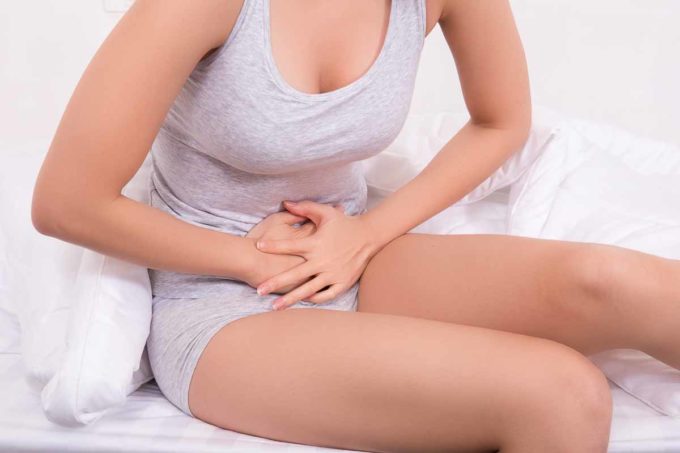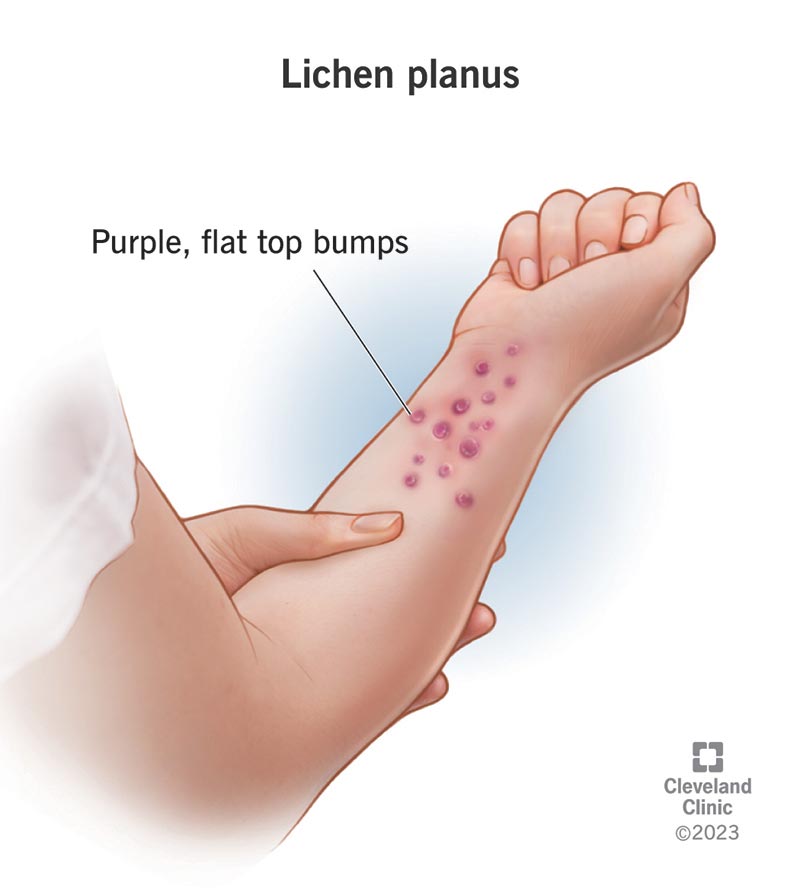آخرین مطالب
امکانات وب
لیکن پلان (Lichen planus) یا خزه پوستی یک بیماری التهابی نسبتاً شایع پوست و مخاط است. اگرچه این بیماری غالباً در افراد میان سال رخ میدهد، اما احتمال ابتلاء در هر سنی وجود دارد.واژه لیکن پلان از یونانی و لاتین و به معنی «خزه تخت و صاف» است.
Lichen planus affects approximately 1% of the population worldwide, mostly affecting adults aged between 30 to 60 years. It has no strong racial predilection.
Lichen planus is a non-infectious, itchy rash that can affect many areas of the body. Affected areas can include the: arms, legs and trunk. mouth (oral lichen planus) nails and scalp.
Lichen planus is a non-infectious, itchy rash that can affect many areas of the body.
Affected areas can include the: eResearch by Navid Ajamin -- autumn 2023
- arms, legs and trunk
- mouth (oral lichen planus)
- nails and scalp
- vulva, vagina and penis
However, the condition isn't infectious and doesn't usually run in families. It can't be passed on to other people, including sexual partners.
What are the 3 types of lichen planus?
- Cutaneous lichen planus.
- Mucosal lichen planus.
- Lichen planopilaris. Lichen planus of the nails.
Lichen planus (LP) is a chronic inflammatory condition affecting the skin and mucosal surfaces. There are several clinical types:
- Cutaneous lichen planus
- Mucosal lichen planus
- Lichen planopilaris
- Lichen planus of the nails
- Lichen planus pigmentosus
- Lichenoid drug eruption.
Is lichen planus autoimmune or not?
Lichen planus is a chronic inflammatory dermatosis of autoimmune origin that usually manifests in the oral mucosa.
What is the main cause of lichen planus?
The cause of lichen planus is unknown. It's thought to be related to the immune system, or an abnormal response of the immune system to certain medicines. Lichen planus isn't infectious, doesn't usually run in families and can't be passed on to others.

Lichen planus is a T-cell mediated autoimmune disorder in which inflammatory cells attack an unknown protein within the skin and mucosal keratinocytes.
Contributing factors to lichen planus may include:
- Genetic predisposition
- Physical and emotional stress
- Injury to the skin; lichen planus often appears where the skin has been scratched or after surgery (koebnerisation)
- Localised skin disease such as herpes zoster
- Systemic viral infection, such as hepatitis C (which might modify self-antigens on the surface of basal keratinocytes)
- Contact allergy, such as to metal fillings in oral lichen planus (rare) and colour photographic developers
- Drugs; gold, quinine, quinidine, and others can cause a lichenoid rash.
Lichenoid inflammation is also notable in graft-versus-host disease.
Vitamin D deficiency may be associated with oral lichen planus. Its association with other types of LP remains unexplored.
Which vitamin deficiency causes lichen planus?
Conclusion. Oral lichen planus causes serum vitamin B12 deficiency. Vitamin B12 is linked with normal functioning of immune and neuropsychologic system which has a role to play in etiopathogenesis and malignant transformation of oral lichen planus.
What is the best vitamin for lichen planus?
Vitamin D and its associated VDR have an anti-inflammatory role in OLP through regulation of the nuclear factor-γB (NF-γB) pathway. VDR expression is reduced in Th1-mediated diseases.
How do you diagnose lichen planus?
The lesions are often covered by lacy, reticular, white lines known as Wickham striae. Classic cases of lichen planus may be diagnosed clinically, but a 4-mm punch biopsy is often helpful and is required for more atypical cases.
What is the best treatment for lichen planus?
Light therapy may help clear up lichen planus affecting the skin. This approach is also called phototherapy. One method involves exposing the affected skin to ultraviolet B light 2 to 3 times a week for several weeks.

How is lichen planus managed?
Lichen planus on your skin usually gets better on its own in about 9 to 18 months. Creams and ointments from a GP can help control the rash and ease itching. If creams and ointments do not work, or you have severe lichen planus, steroid tablets or treatment with a special kind of light (light therapy) can help.
Lichen planus (LP) is an inflammatory disorder of the skin and mucous membranes with no known cause. It appears as pruritic, violaceous papules and plaques most commonly found on the wrists, lower back, and ankles. A lattice-like network of white lines called Wickham striae overlies the lesions but is most easily observed on the buccal mucosa where erosions can also be present. Drug-induced lichen planus, or lichenoid drug eruption, is frequently photo distributed but may be indistinguishable from idiopathic LP.
There's no single treatment that can cure lichen planus completely. However, treatments are available to help manage the symptoms and make living with it easier. For example, steroid creams or ointments are often used to help relieve the itch and control the rash.
Most cases of lichen planus of the skin clear up on their own within 6 to 9 months. The rash rarely lasts longer than 18 months. However, oral lichen planus and lichen planus that affects the genital area may be more persistent.
Erosive lichen planus is a rare form of lichen planus that can last a long time. It causes painful ulcers to develop in the mouth and in the genital areas of both males and females.
In some cases, long-term erosive lichen planus can increase the chance of some types of cancer developing.
Treatment
If you have no pain or discomfort, you may not need any treatment. Lichen planus on the skin often clears up on its own in months to years.
Medicines and other treatments might help relieve itching, ease pain and speed healing. Talk with your health care provider to weigh the pros and cons of treatment options. You may need more than one approach to control your symptoms.
If the disease affects your mucous membranes and nails, it tends to be harder to treat. Even if treatment works, the symptoms may return. You'll likely need to visit your health care provider for follow-up care at least once a year.
Corticosteroids
Often, the first choice for treatment of lichen planus of the skin is a prescription corticosteroid cream or ointment. This may help ease pain, swelling and inflammation.
If a topical corticosteroid doesn't help and your condition is severe or widespread, your health care provider might suggest corticosteroid pills or injections.
Side effects vary, depending on the method of use. Corticosteroids are safe when used as directed.
Oral anti-infections drugs
Other oral medicines used for lichen planus are the antimalarial hydroxychloroquine (Plaquenil) and the antibiotic metronidazole (Flagyl, others).
Immune response medicines
For more-severe symptoms, you may need prescription medicine that changes your body's immune response. The following drugs have been used with some success but further study is needed:
- cyclosporine (Sandimmune).
- Azathioprine (Azasan).
- methotrexate (Trexall).
- mycophenolate (Cellcept).
- sulfasalazine.
- thalidomide (Thalomid).
Antihistamines
An antihistamine medicine taken by mouth might ease the itchy skin caused by lichen planus.
Light therapy
Light therapy may help clear up lichen planus affecting the skin. This approach is also called phototherapy. One method involves exposing the affected skin to ultraviolet B light 2 to 3 times a week for several weeks.
One possible side effect is lasting changes in skin color (postinflammatory hyperpigmentation) even after the skin heals.
Retinoids
Your health care provider might prescribe a retinoid medicine taken by mouth or applied to the skin. One example is acitretin.
Retinoids can cause birth defects, so this type of medicine isn't for people who are pregnant or may become pregnant. If you're pregnant or nursing, your health care provider may suggest that you delay treatment or choose a different treatment.

However, some key differences set the two apart. Lichen sclerosus presents more as hypopigmentation (i.e., a lightening of the skin), and erosive lichen planus presents more as bright red, glassy-looking erosions. Erosive lichen planus can affect the vulva and vagina.
What foods and drinks should I avoid if I have lichen planus?
If you have oral lichen planus, it’s a good idea to avoid spicy or acidic foods or drinks that may cause further irritation, including:
- Hot peppers.
- Salsas.
- Citrus fruits.
- Tomatoes.
- Alcohol.
In addition to avoiding spicy and acidic foods and drinks, you should avoid smoking.
Are there any home remedies for symptoms of lichen planus?
There are several over-the-counter products or home remedies that can help stop your rash from itching.
While home remedies are safe for most people, it’s a good idea to check with your healthcare provider before trying some of the following options. You may be at risk of developing an allergic reaction.
- Aloe vera. Aloe vera is a wound care gel that can moisturize, heal and treat sores. Some research suggests that it can relieve lichen planus symptoms in your mouth or on your vulva.
- Antihistamines. Antihistamines are a class of drugs commonly used to treat allergy symptoms, including itchy skin.
- Hydrocortisone creams or ointments. Over-the-counter (OTC) hydrocortisone is a corticosteroid combined with an anesthetic pain reliever.
- Oatmeal: Oatmeal contains gluten, which can soothe itchiness. The best way to use oatmeal on your lichen planus skin rash is to grind it into a fine powder (colloidal oatmeal) in a blender or food processor. Mix the oatmeal powder with warm water until it becomes a thick, sticky paste. Apply enough of the oatmeal paste to cover your rash completely. After at least 10 minutes, wipe off the paste with a clean towel.
Stress can also make skin disease worse. There are mental/emotional signs of stress and physical signs of stress. Stress management techniques can help you prevent or ease your stress-induced lichen planus symptoms.
Reference:
- mayoclinic.org/diseases-conditions/lichen-planus/diagnosis-treatment/drc-20351383
- lssupportnetwork.org/lichen-planus-or-lichen-sclerosus-can-you-have-both
- nhsinform.scot/illnesses-and-conditions/skin-hair-and-nails/lichen-planus
- my.clevelandclinic.org/health/diseases/17723-lichen-planus
- dermnetnz.org/topics/lichen-planus
- ncbi.nlm.nih.gov/books/NBK526126
- fa.wikipedia.org/wiki
برچسب : نویسنده : healthy4you بازدید : 56

